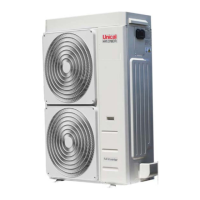7
4.4 REFRIGERANT SAFETY DATA SHEET
Quick evaporation could cause it to freeze.
Do not administer to people who are unconscious.
Immediately remove to fresh air.
Use oxygen or artificial respiration as required.
The use of adrenaline or similar drugs should be avoided.
Carefully rinse with plenty of water for at least 15 minutes and get medical attention.
Wash immediately with plenty of water for at least 15 minutes. Apply a sterile gauze.
Immediately remove contaminated clothing.
Breakage or explosion of vessel.
Specific methods:
Cool down the containers with a water spray from a safe position. Stop the product leakage if possible.
Use water spray, if possible, to abate the fumes. Move the vessels away from the area of the fire if this
can be done without posing any risks.
ACCIDENTAL RELEASE MEASURES
Personal precautions:
Try to stop the leak.
Evacuate personnel to safety areas.
Eliminate the ignition sources.
Ventilate appropriately.
Use personal protective equipment.
Environmental
precautions:
Try to stop the leak.
technical
measures/precautions:
Allow efficient air exchange and/or suction the work environments.
Do not breath in fumes or aerosol.
Close carefully and store in a cool, dry and well ventilated area.
Keep in original containers. Incompatible products: explosive, flammable materials, organic peroxide
EXPOSURE CONTROLS/PERSONAL PROTECTION
Control parameters:
OEL – data not available.
DNEL: Derived no effect level (workers)
long-term – systemic effects, inhalation = 7035 mg/m
3
.
PNEC: Predicted no-effect concentration
water (fresh water) = 0.142 mg/l
aquatic, intermittent releases = 1.42 mg/l
sediment, fresh water = 0.534 mg/kg dry weight
PHYSICAL AND CHEMICAL PROPERTIES
Ethereal. Hard to perceive at low concentrations.
Relative gas density (air =1)
Relative liquid density
1.8.
1.1.

